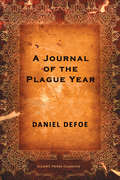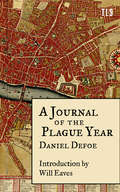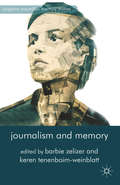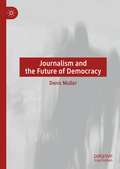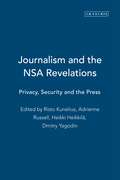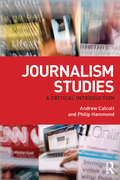- Table View
- List View
Journal 1935-44
by Mihail Sebastian'Deserves to be on the same shelf as Anne Frank's Diary and to find as huge a readership' - Philip RothMihail Sebastian was a promising young Jewish writer in pre-war Bucharest, a novelist, playwright, poet and journalist who counted among his friends the leading intellectuals and social luminaries of a sophisticated Eastern European culture. Because of Romania's opportunistic treatment of Jews, he survived the war and the Holocaust, only to be killed in a road accident early in 1945. His remarkable diary was published only recently in its original language and is here translated into English for the first time. Sebastian's Journal offers not only a chronicle of the darkest years of European anti-Semitism but a lucid and finely shaded analysis of erotic and social life, a reader's notebook, and a music lover's journal. Above all, it is a measured but blistering account of the major Romanian intellectuals, Sebastian's friends, writers and thinkers who were mesmerised by the Nazi-fascist delirium of Europe's 'reactionary revolution'. In poignant and memorable sequences, Sebastian touches on the progression of the machinery of brutalisation and on the historical context that lay behind it. One of the most remarkable literary achievements of the Nazi period, Sebastian's journal vividly captures the now-vanished world of pre-war Bucharest. Under the pressure of hatred and horror in the 'huge anti-Semitic factory' that was Romania in the years of World War II, his writing maintains the grace of its intelligence, standing as one of the most important human and literary documents to survive from a singular era of terror and despair.
The Journal and Letters of Captain Charles Bishop on the North-West Coast of America, in the Pacific, and in New South Wales, 1794-1799 (Hakluyt Society, Second Series)
by Michael RoeIn 1794, Charles Bishop sailed from Bristol as master of the Ruby, a trading ship bound for north-west America. He had instructions to procure otter furs from the Indians and then to proced to Canton via Japan and sell the cargo. During the years 1794-1802, he rounded South America to reach the Pacific coast, then visited the Pacific islands and the coasts of Asia and Australia. In the Moluccas, he sold the Ruby and purchased the Nautilus; correspondingly, the text is divided into two sections. This narrative is Bishop's journal of his voyages and relates a minor epic of adventure, courage and turbulent fortune. The records of his letters and financial accounts show something of the ships' general organization, and of the seamen who served such expeditions. Bishop also describes the various ports and peoples he encountered; his experiences typify European contacts in the Pacific, and the reaction between trader, missionary, administrator and local inhabitant. Dr Roe's introduction gives the background to the trading voyages of the 18th century and describes Bishop's pwn history. Records of his life continue until 1809, ending tragically in Sydney, where he passed some years in poverty and insanity, before being returned to England. . This is a new print-on-demand hardback edition of the volume first published in 1967.
The Journal and Letters of Captain Charles Bishop on the North-West Coast of America, in the Pacific, and in New South Wales, 1794-1799 (Hakluyt Society, Second Series)
by Michael RoeIn 1794, Charles Bishop sailed from Bristol as master of the Ruby, a trading ship bound for north-west America. He had instructions to procure otter furs from the Indians and then to proced to Canton via Japan and sell the cargo. During the years 1794-1802, he rounded South America to reach the Pacific coast, then visited the Pacific islands and the coasts of Asia and Australia. In the Moluccas, he sold the Ruby and purchased the Nautilus; correspondingly, the text is divided into two sections. This narrative is Bishop's journal of his voyages and relates a minor epic of adventure, courage and turbulent fortune. The records of his letters and financial accounts show something of the ships' general organization, and of the seamen who served such expeditions. Bishop also describes the various ports and peoples he encountered; his experiences typify European contacts in the Pacific, and the reaction between trader, missionary, administrator and local inhabitant. Dr Roe's introduction gives the background to the trading voyages of the 18th century and describes Bishop's pwn history. Records of his life continue until 1809, ending tragically in Sydney, where he passed some years in poverty and insanity, before being returned to England. . This is a new print-on-demand hardback edition of the volume first published in 1967.
The Journal of Christopher Columbus: And Documents relating to the Voyages of John Cabot and Gaspar Corte Real (Hakluyt Society, First Series)
by Clements R. MarkhamTranslated, with Notes and an Introduction, and including Paolo Toscanelli's sailing directions in letters to Columbus, and documents relating to Sebastian Cabot. This is a new print-on-demand hardback edition of the volume first published in 1893.
The Journal of Christopher Columbus: And Documents relating to the Voyages of John Cabot and Gaspar Corte Real (Hakluyt Society, First Series)
by Clements R. MarkhamTranslated, with Notes and an Introduction, and including Paolo Toscanelli's sailing directions in letters to Columbus, and documents relating to Sebastian Cabot. This is a new print-on-demand hardback edition of the volume first published in 1893.
The Journal of Dora Damage: A Novel
by Belinda StarlingLondon, 1860: On the brink of destitution, Dora Damage illicitly takes over her ailing husband's bookbinding business, only to find herself lured into binding expensive volumes of pornography commissioned by aristocratic roués. Dora's charm and indefatigable spirit carry her through this rude awakening as she contends with violent debt collectors, an epileptic daughter, evil doctors, a rheumatic husband, errant workmen, nosy neighbors, and a constant stream of wealthy dilettantes. When she suddenly finds herself forced to offer an internship to a mysterious, fugitive American slave, Dora realizes she has been pulled into in an illegal trade of sex, money, and deceit. The Journal of Dora Damage conjures a vision of London when it was the largest city in the world, grappling with the filth produced by a swollen population. Against a backdrop of power and politics, work and idleness, conservatism and abolitionism, Belinda Starling explores the restrictions of gender, class, and race, the ties of family and love, and the price of freedom in this wholly engrossing debut novel. REVIEWS: "Unfortunately, Starling's debut novel will be her last; she died prematurely last year at the age of 34. Although the plot is a bit too crowded and overworked-a common novice mistake-this historical melodrama artfully evokes the contradictions inherent in Victorian society. When Dora Damage is forced by circumstances-an invalid husband and an epileptic daughter-to take over the family bookbinding business, she is inexorably drawn into a London netherworld she barely knew existed. As if binding pornographic books for a circle of aristocratic clients isn't bad enough, she is also compelled to harbor Din Nelson, a fugitive American slave. Unable to suppress her emotional and physical attraction for Din, she gives into desire and her real education begins."- Booklist
The Journal of John Jourdain, 1608-1617, describing his Experiences in Arabia, India, and the Malay Archipelago (Hakluyt Society, Second Series)
by William FosterAn account of the East India Company's fourth voyage; with an appendix containing William Revett's 1609 account of the Seychelles, and reports on other places by merchants and seamen of the same period. Appendices: A. William Revett's account of the Seychelles. B. William Revett's narrative of events at Aden, his voyage to Mocha, etc. C. Captain Sharpeigh's account of events at Aden and Mocha, of the shipwreck, and of his subsequent journey to Agra. D. William Finch's description of Ma?ndu? and Gwalior. E. Coen's narrative of the visit of the Darling to Amboyna and Ceram. F. The fight at Patani and death of Jourdain. "Bibliography (by Basil H. Soulsby)": p. [375]-384. This is a new print-on-demand hardback edition of the volume first published in 1905.
The Journal of John Jourdain, 1608-1617, describing his Experiences in Arabia, India, and the Malay Archipelago (Hakluyt Society, Second Series)
by William FosterAn account of the East India Company's fourth voyage; with an appendix containing William Revett's 1609 account of the Seychelles, and reports on other places by merchants and seamen of the same period. Appendices: A. William Revett's account of the Seychelles. B. William Revett's narrative of events at Aden, his voyage to Mocha, etc. C. Captain Sharpeigh's account of events at Aden and Mocha, of the shipwreck, and of his subsequent journey to Agra. D. William Finch's description of Ma?ndu? and Gwalior. E. Coen's narrative of the visit of the Darling to Amboyna and Ceram. F. The fight at Patani and death of Jourdain. "Bibliography (by Basil H. Soulsby)": p. [375]-384. This is a new print-on-demand hardback edition of the volume first published in 1905.
A Journal of the Plague Year
by Daniel DefoeA London narrator recounts both the personal and the political happenings of a single year during the Great Plague in the seventeenth century.
A Journal of the Plague Year (Pony Club Secrets Ser. #10)
by Daniel DefoeWelcome to London in lockdown – in 1665 This timely re-release of Defoe’s classic comes with an introduction by Wellcome-Prize-winning author, Will Eaves.
A Journal of the Plague Year (Oxford World's Classics)
by Daniel Defoe'a Casement violently opened just over my Head, and a Woman gave three frightful Skreetches, and then cry'd, Oh! Death, Death, Death!' Purporting to be an eye-witness account, the Journal of the Plague Year is a record of the devastation wrought by the Great Plague of 1665 on the city of London. Defoe's fictional narrator, known only as 'H. F.', recounts in vivid detail the progress of the disease and the desperate attempts to contain it. He catalogues the rising death toll and the transformation of the city as its citizens flee and those who remain live in fear and despair. Above all it is the stories of appalling human suffering and grief that give Defoe's extraordinary fiction its compelling historical veracity. This revised edition includes comprehensive notes, a complete topographical index, and a new introduction to the greatest work of plague literature. ABOUT THE SERIES: For over 100 years Oxford World's Classics has made available the widest range of literature from around the globe. Each affordable volume reflects Oxford's commitment to scholarship, providing the most accurate text plus a wealth of other valuable features, including expert introductions by leading authorities, helpful notes to clarify the text, up-to-date bibliographies for further study, and much more.
A Journal of the Plague Year / Written by a Citizen Who Continued All the While in London
by Daniel DefoeThis novel is an account of one man's experiences of the year 1665, in which the Great Plague or the bubonic plague struck the city of London. The book is told somewhat chronologically, though without sections or chapter headings. <P> <P> Presented as an eyewitness account of the events at the time, it was written in the years just prior to the book's first publication in March 1722. Defoe was only five years old in 1665, and the book itself was published under the initials H. F. and is probably based on the journals of Defoe's uncle, Henry Foe. In the book, Defoe goes to great pains to achieve an effect of verisimilitude, identifying specific neighborhoods, streets, and even houses in which events took place. Additionally, it provides tables of casualty figures and discusses the credibility of various accounts and anecdotes received by the narrator. The novel is often compared to the actual, contemporary accounts of the plague in the diary of Samuel Pepys. Defoe's account, which appears to include much research, is far more systematic and detailed than Pepys's first-person account.
Journal of the Travels and Labours of Father Samuel Fritz in the River of the Amazons between 1686 and 1723 (Hakluyt Society, Second Series)
by THE REV. DR. GEORGE EDMUNDSONTranslated from the Evora MS. and edited, with a translation of the Act of Possession of Pedro Teixeira, 1639, and of contemporary references in Portuguese sources to the work of Father Fritz in the Upper Amazon. This is a new print-on-demand hardback edition of the volume first published in 1922. Owing to technical constraints it has not been possible to reproduce Fritz's Map of 1707 which was included in the first edition of the work.
Journal of the Travels and Labours of Father Samuel Fritz in the River of the Amazons between 1686 and 1723 (Hakluyt Society, Second Series)
by The Rev. George EdmundsonTranslated from the Evora MS. and edited, with a translation of the Act of Possession of Pedro Teixeira, 1639, and of contemporary references in Portuguese sources to the work of Father Fritz in the Upper Amazon. This is a new print-on-demand hardback edition of the volume first published in 1922. Owing to technical constraints it has not been possible to reproduce Fritz's Map of 1707 which was included in the first edition of the work.
Journalism 'a Peacekeeping Agent' at the Time of Conflict (International Comparative Social Studies #40)
by Yasemin İnceoğlu Tirşe FilibeliJournalism a Peacekeeping Agent at the Time of Conflict offers a critical analysis medias role on peace-making and conflict-resolution.
Journalism Across Boundaries: The Promises And Challenges Of Transnational And Transborder Journalism
by K. GrievesJournalistic activity crosses national borders in creative and sometimes unexpected ways. Drawing on many interviews and newsroom observation, this book addresses an overlooked but important aspect of international journalism by examining how journalists carry out their daily work at the transnational and regional transborder level.
Journalism and Austerity: Digitization and Crisis During the Greek Memoranda (Digital Activism And Society: Politics, Economy And Culture In Network Communication)
by Christos KostopoulosJournalism and Austerity: Digitization and Crisis During the Greek Memoranda presents an overview of press coverage focused on the Greek crisis. The impacts of disaster and digitization in Greek journalism are analyzed with the help of expert testimonies in one of the most significant political cases of the decade. The author examines the increased use of digital technologies during the economic crisis, and the production of democratic debate around the memoranda in Greece, alongside the interplay between framing and political economic theories. The book enhances our understanding of journalistic production around significant political issues, such as the case of the memoranda signed between the Greek government and the European troika. In this case, the debate was presented in the dominant newspapers of the period in a polarized manner, cut off from global debates The author presents a multi-level theoretical model of power influences on the frame building process, along with his findings from a frame analysis of media articles and political announcements. The book also includes interviews with elite Greek journalists.
Journalism and Austerity: Digitization and Crisis During the Greek Memoranda (Digital Activism And Society: Politics, Economy And Culture In Network Communication)
by Christos KostopoulosJournalism and Austerity: Digitization and Crisis During the Greek Memoranda presents an overview of press coverage focused on the Greek crisis. The impacts of disaster and digitization in Greek journalism are analyzed with the help of expert testimonies in one of the most significant political cases of the decade. The author examines the increased use of digital technologies during the economic crisis, and the production of democratic debate around the memoranda in Greece, alongside the interplay between framing and political economic theories. The book enhances our understanding of journalistic production around significant political issues, such as the case of the memoranda signed between the Greek government and the European troika. In this case, the debate was presented in the dominant newspapers of the period in a polarized manner, cut off from global debates The author presents a multi-level theoretical model of power influences on the frame building process, along with his findings from a frame analysis of media articles and political announcements. The book also includes interviews with elite Greek journalists.
Journalism and Memory (Palgrave Macmillan Memory Studies)
by Barbie Zelizer Keren Tenenboim-WeinblattTracking the ways in which journalism and memory mutually support, undermine, repair and challenge each other, this fascinating collection brings together leading scholars in journalism and memory studies to investigate the complicated role that journalism plays in relation to the past.
Journalism and the American Experience
by Bruce J. EvensenJournalism and the American Experience offers a comprehensive examination of the critical role journalism has played in the struggle over America’s democratic institutions and culture. Journalism is central to the story of the nation’s founding and has continued to influence and shape debates over public policy, American exceptionalism, and the meaning and significance of the United States in world history. Placed at the intersection of American Studies and Communications scholarship, this book provides an essential introduction to journalism’s curious and conflicted co-existence with the American democratic experiment.
Journalism and the Future of Democracy
by Denis MullerThis book is about how journalism can contribute to the recovery of democracy from the crisis exemplified by the Trump presidency, the Brexit referendum and the rise of populism across the Western world. It explores the ethical concepts that provide the foundation for journalism in modern democracies: pluralism, liberalism, tolerance, truth, free speech, and impartiality. History has shown that crisis brings opportunity for change on a scale that is unachievable under ordinary political conditions, and this book proposes fundamental ways in which journalism can help democratic societies seize the moment. It traces the development of traditional mass media and social media and explores how the two might work better together to benefit democratic life. The development of press theory is described, and enhanced by a proposed new theory, Democratic Revival.
Journalism and the Nsa Revelations: Privacy, Security and the Press (Reuters Institute for the Study of Journalism)
by Dmitry Yagodin Heikki Heikkilä Risto Kunelius Adrienne RussellEdward Snowden's revelations about the mass surveillance capabilities of the US National Security Agency (NSA) and other security services triggered an ongoing debate about the relationship between privacy and security in the digital world. This discussion has been dispersed into a number of national platforms, reflecting local political realities but also raising questions that cut across national public spheres. What does this debate tell us about the role of journalism in making sense of global events? This book looks at discussions of these debates in the mainstream media in the USA, United Kingdom, France, Germany, Russia and China. The chapters focus on editorials, commentaries and op-eds and look at how opinion-based journalism has negotiated key questions on the legitimacy of surveillance and its implications to security and privacy. The authors provide a thoughtful analysis of the possibilities and limits of 'transnational journalism' at a crucial time of political and digital change
Journalism in the Fallen Confederacy
by Debra Reddin van TuyllDuring the American Civil War, several newspapers remained Confederate sympathizers despite their locations being occupied by Union troops. Examining these papers, the authors explore what methods of suppression occupiers used, how occupation influenced the editorial and business sides of the press, and how occupation impacted freedom of the press.
Journalism Studies: A Critical Introduction
by Andrew Calcutt Philip HammondAs the world of politics and public affairs has gradually changed beyond recognition over the past two decades, journalism too has been transformed... yet the study of news and journalism often seems stuck with ideas and debates which have lost much of their critical purchase. Journalism is at a crossroads: it needs to reaffirm core values and rediscover key activities, almost certainly in new forms, or it risks losing its distinctive character as well as its commercial basis. Journalism Studies is a polemical textbook that rethinks the field of journalism studies for the contemporary era. Organised around three central themes – ownership, objectivity and the public – Journalism Studies addresses the contexts in which journalism is produced, practised and disseminated. It outlines key issues and debates, reviewing established lines of critique in relation to the state of contemporary journalism, then offering alternative ways of approaching these issues, seeking to reconceptualise them in order to suggest an agenda for change and development in both journalism studies and journalism itself. Journalism Studies is a concise and accessible introduction to contemporary journalism studies, and will be highly useful to undergraduate and postgraduate students on a range of Journalism, Media and Communications courses.






